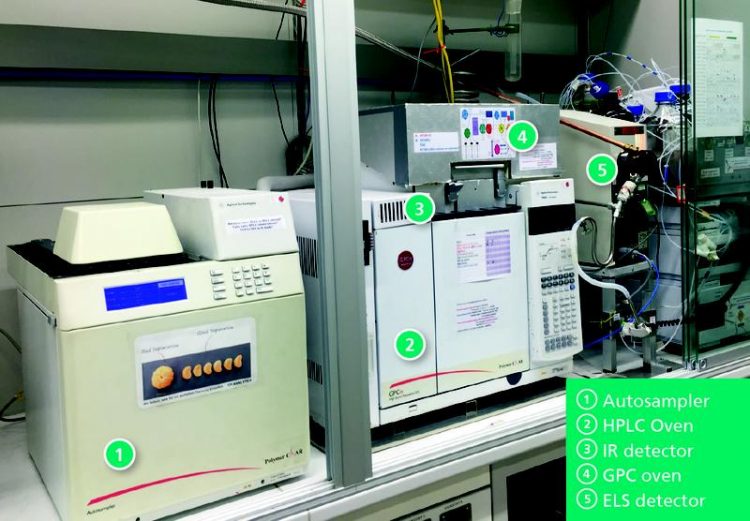How effective are bonding agents? Fraunhofer uses liquid chromatography for characterization

Device for separating polyolefins using 2-dimensional high temperature liquid chromatography. Photo: Fraunhofer LBF
This is very useful for the development of more efficient functionalization processes. In addition, this analytic information is highly relevant for material development and for understanding material failure.
Due to their properties, which can be broadly adjusted, and because they are manufactured from inexpensive raw materials, polyolefins are the most frequently used synthetic polymers. However, their low surface energy, poor compatibility with polar polymers, and low adhesion to polar materials do represent limits to how they are used.
Many of these problems can be solved by introducing polar functions, for instance through grafting them with appropriate polar monomers. The molar mass distribution (MMD) and chemical composition distribution (CCD) then determine the application characteristics for a given total composition.
Previously established methods could not be used to determine the distribution of the chemical composition. That is why scientists at the Fraunhofer Institute developed a fast and selective method for characterizing functionalized polyolefins with an approach based on high performance liquid chromatography (HPLC). This allowed them to separate functionalized polyolefins, such as polypropylene-grafted maleic anhydride (PP-g-MA) into polar and non-polar fractions.
This allows them to quickly and easily identify the fraction of the sample active as a bonding agent (functionalized), and then determine the effectiveness of the grafting process. The scientists further developed the HPLC approach to obtain information on the degree of functionalization of polymer chains of different lengths (different molar mass), i.e. the relationship between MMD and CCD. Combining HPLC with gel permeation chromatography (GPC) made it possible to separate PP-g-MA samples based on their chemical composition and then on their molar mass.
First, this method made it possible to determine the actual active content of functionalized polypropylene in a quantitative way for the first time. Second, it could be used to show that the functionalized material had a lower molar mass than the non-functionalized fraction.
About Fraunhofer LBF’s plastics research Division
Fraunhofer LBF’s plastics research division, which evolved out of the German Plastics Institute [Deutsches Kunststoff-Institut DKI], provides its customers with advice and support along the entire added value chain from polymer synthesis to the material, its processing and product design through to the qualification and verification of complex safety-critical lightweight construction systems. The research division specializes in the management of complete development processes and advises its customers at all stages of development. High-performance thermoplastics and compounds, duromers, duromer composites and duromer compounds as well as thermoplastic elastomers play a key role. The plastics division is an identified skills center for questions regarding additivation, formulation and hybrids. It has extensive expertise in analyzing and characterizing plastics and the changes in their properties during processing and in use, and also in developing methods for time-resolved processes.
Media Contact
More Information:
http://www.lbf.fraunhofer.deAll latest news from the category: Materials Sciences
Materials management deals with the research, development, manufacturing and processing of raw and industrial materials. Key aspects here are biological and medical issues, which play an increasingly important role in this field.
innovations-report offers in-depth articles related to the development and application of materials and the structure and properties of new materials.
Newest articles

High-energy-density aqueous battery based on halogen multi-electron transfer
Traditional non-aqueous lithium-ion batteries have a high energy density, but their safety is compromised due to the flammable organic electrolytes they utilize. Aqueous batteries use water as the solvent for…

First-ever combined heart pump and pig kidney transplant
…gives new hope to patient with terminal illness. Surgeons at NYU Langone Health performed the first-ever combined mechanical heart pump and gene-edited pig kidney transplant surgery in a 54-year-old woman…

Biophysics: Testing how well biomarkers work
LMU researchers have developed a method to determine how reliably target proteins can be labeled using super-resolution fluorescence microscopy. Modern microscopy techniques make it possible to examine the inner workings…





















